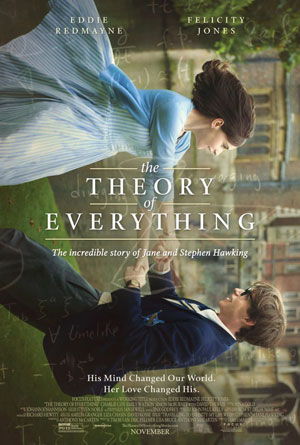Redmayne, Jones shine in ‘The Theory of Everything’

theoryposter.jpg
Too often, Hollywood romantic dramas fall flat and have few to no redeeming traits. The stories are fluffed, not relatable, feature sub-par acting by pretty faces and almost always feature predictable endings. Every so often, however, a movie comes along within the genre that feels real — that depicts and exemplifies the struggles that can arise alongside love.
On the surface, The Theory of Everything is the story of world-renowned physicist Stephen Hawking’s (played by Eddie Redmayne) life from his days as a student at Cambridge to the later stages of his adulthood. This works because Hawking’s life has been about as much of a rollercoaster ride as a life could be.
In the movie, though, his life itself quickly becomes the second narrative — taking a backseat to the lives of Hawking and his partner Jane Wilde (played by Felicity Jones). It’s the story of a blossoming relationship and its falling apart, the story of philosophical differences and the story of struggle.
The two meet at a party held on the campus of Cambridge University. Jane is immediately fascinated by the gangly, awkward and spectacled Hawking, who is far from an expert at talking to her.
The first conflict is introduced quickly when the topic of religion arises. Wilde is a devout Catholic, but Hawking, whose life mission has been to scientifically prove the beginning of time, religion is not only not an option, but directly in opposition to his career.
The two hardly pay note to the philosophical differences at the start, however, and begin engaging in a romantic relationship. The narrative does return to the religious question later in the film.
The second conflict comes to the surface when Hawking is diagnosed with motor neuron disease after taking a nasty spill on campus. Motor neuron disease, also known as Lou Gehrig’s disease, results in the loss of motor skills and degenerates muscle, leading to eventual death. The disease doesn’t affect the brain.
Despite the diagnosis, Wilde and Hawking are eventually wed. It’s apparent that Wilde believes she knows what she is in for and understands the trials that lie ahead, but in the long run she doesn’t.
The two are happily married in the beginning — even having children together. As the children age and Hawking grows weaker and weaker, gradually losing all strength and being bound to a wheelchair, the struggles become unbearable for Wilde. Desperate for help, Wilde recruits a local church choir leader to assist with daily tasks.
Wilde eventually begins to fall for the choir leader, alienating the disabled Hawking. As the movie progresses, Hawking cares less about the outside world and focuses almost solely on his studies. The two’s differences eventually pass the point of fixing and they divorce.
Redmayne gives a tremendous performance playing the role of Hawking. The physical resemblances help, but Redmayne seems like he is an actual sufferer of the disease and never leaves a moment of doubt in his performance. He won the Golden Globe for Best Lead Actor for good reason and will likely walk away with the same award at the Oscars.
Occasionally, such a flawless performance from one character can make the other characters seem small, but Jones matches Redmayne blow for blow, refusing to fall into his shadow. Jones is ripe with emotion and her performance never seems forced; she perfectly portrays the struggles that can come with marriage and parenthood. Rightfully so, Jones received a nomination for Best Lead Actress at the Oscars.
Ultimately, The Theory of Everything is the true story of a relationship that didn’t work due to unforeseen circumstances. Brilliant lead acting takes the film above and beyond expectations and results in one of the most genuine romances since the French Film Amour was released in 2012.
Your donation will support the student journalists of Missouri Southern State University. Your contribution will allow us to purchase equipment and cover our annual website hosting costs.















